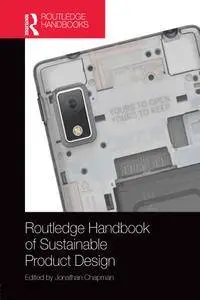Routledge Handbook of Sustainable Product Design
CRC Press | English | 2017 | ISBN-10: 1138910171 | 584 pages | PDF | 6.20 MB
CRC Press | English | 2017 | ISBN-10: 1138910171 | 584 pages | PDF | 6.20 MB
by Jonathan Chapman (Author)
As a cultivated form of invention, product design is a deeply human phenomenon that enables us to shape, modify and alter the world around us – for better or worse. The recent emergence of the sustainability imperative in product design compels us to recalibrate the parameters of good design in an unsustainable age. Written by designers, for designers, the Routledge Handbook of Sustainable Product Design presents the first systematic overview of the burgeoning field of sustainable product design. Brimming with intelligent viewpoints, critical propositions, practical examples and rich theoretical analyses, this book provides an essential point of reference for scholars and practitioners at the intersection of product design and sustainability. The book takes readers to the depth of our engagements with the designed world to advance the social and ecological purpose of product design as a critical twenty-first-century practice. Comprising 35 chapters across 6 thematic parts, the book’s contributors include the most significant international thinkers in this dynamic and evolving field.
Review
‘Brimming with intelligent viewpoints, critical propositions, practical examples and rich theoretical analyses, this book provides an essential point of reference for scholars and practitioners at the intersection of product design and sustainability.’ - John Thackara, founder, Doors of Perception
'To profoundly understand something, you need to study it from all possible angles. This impressive volume does exactly this. With contributions by leading scholars from a diverse range of backgrounds, it brings us the multidisciplinary perspective on sustainable product design that designers, academics, and – ultimately – the world so desperately need.' - Paul Hekkert, Professor, Department of Industrial Design, Delft University of Technology
'The case against mindless design has never been made more effectively. Chapman brings together an amazing assembly of contemporary design researchers to discuss one of our greatest challenges: making the world safe for future inhabitants. Whatever you are designing, you may want to keep this book close to remind you of all the exciting new possibilities for sustainable design.' - Dr. Conny Bakker, Associate Professor, Design for Sustainability / Circular Product Design, TU Delft
‘Product design is at a crossroads with product designers now a fractured constituency. The difference can be viewed in three ways: retaining the historically established focus on the object, be it so often bonded to the unsustainable; redeeming the object by attempting to make it ‘sustainable’; or lastly, abandoning, eliminating or dematerialising it. This collection of essays gives the discerning reader the opportunity to make an informed decision on the most appropriate path design and designing should take.’ - Professor Tony Fry, Director, Studio at the Edge of the World
About the Author
Jonathan Chapman is Professor and Director of Doctoral Studies at Carnegie Mellon University’s School of Design. His research shapes future design paradigms for longer-lasting materials, products and user experiences – an approach he defines as 'emotionally durable design'. He has developed this research with over 100 global businesses and governmental bodies – from Sony, Puma, The Body Shop and Philips to the House of Lords and the United Nations – advancing the social and ecological relevance of their products, technologies and systems. Professor Chapman's work in sustainable design has generated international media attention from publications such as The New York Times, The Guardian, The Independent, CNN International and BBC Radio 4. New Scientist described him as ‘a mover and shaker’ and a ‘new breed of sustainable design thinker’.



